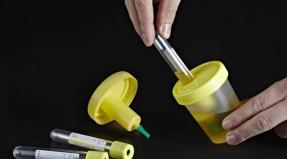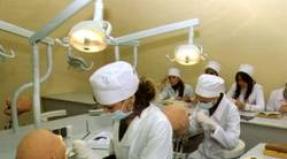The specific gravity of urine is lowered. The relative density of urine: the limits of the normal concentration. How to normalize urine specific gravity
In the article you will read what indicators are included in the general urine analysis, what are the reference intervals for these indicators, what is the norm of leukocytes and erythrocytes in the urine, how much protein and sugar can be in the urine, what epithelial cells are found in the analysis.
The information has been prepared by doctors from the CIR laboratories and clinics.
General clinical examination of urine (general urine analysis, OAM) includes the determination of physical properties, chemical composition and microscopic examination of the sediment.
Physical properties of urine
The main physical properties of urine, determined by OAM:
- transparency
- specific gravity
- pH (urine response)
Urine color
The color of urine normally ranges from light yellow to rich yellow and is due to the pigments it contains (urochrome A, urochrome B, uroetrin, uroresin, etc.).
Reference values:
Interpretation
The intensity of urine color depends on the amount of urine excreted and its specific gravity. Urine of a saturated yellow color is usually concentrated, excreted in small quantities and has a high specific gravity. Very light urine is poorly concentrated, has a low specific gravity and is excreted in large quantities.
Color change can be the result of a pathological process in the urinary system, exposure to dietary components, medications taken.
Transparency (turbidity)
Normal urine is clear. Clouding of urine can be the result of the presence of erythrocytes, leukocytes, epithelium, bacteria, fat droplets, precipitation of salts, pH, mucus, urine storage temperature (low temperature promotes salt loss).
In cases where the urine is cloudy, you should find out whether it is immediately cloudy, or whether this cloudiness occurs some time after standing.
Specific gravity of urine (g / l)
In a healthy person, it can fluctuate over a fairly wide range throughout the day, which is associated with periodic food intake and loss of fluid with sweat and exhaled air.
Interpretation
The specific gravity of urine depends on the amount of substances dissolved in it: urea, uric acid, creatinine, salts.
- A decrease in the specific gravity of urine (hypostenuria) to 1005-1010 g / l indicates a decrease in the concentration capacity of the kidneys, an increase in the amount of urine excreted, and drinking plenty of fluids.
- An increase in the specific gravity of urine (hypersthenuria) of more than 1030 g / l is observed with a decrease in the amount of urine excreted, in patients with acute glomerulonephritis, systemic diseases, with cardiovascular insufficiency, may be associated with the appearance or increase of edema, a large loss of fluid (vomiting, diarrhea ), toxicosis of pregnant women.
Urine reaction (pH)
The pH of urine in a healthy person on a mixed diet is acidic or slightly acidic.
Interpretation
The reaction of urine can vary depending on the nature of the food. The predominance of animal proteins in the diet leads to a sharply acidic reaction, with a vegetable diet, the reaction of urine is alkaline.
- An acidic reaction of urine is observed with fevers of various origins, diabetes mellitus in the stage of decompensation, starvation, and renal failure.
- An alkaline urine reaction is characteristic of cystitis, pyelonephritis, significant hematuria, after vomiting, diarrhea, and the use of alkaline mineral water.
Chemical examination of urine
Currently, the chemical analysis of urine is carried out on automatic analyzers using the dry chemistry method.
Chemical research includes determination in urine:
- squirrel
- glucose
- ketone bodies
Protein in urine, norm of protein in urine
Normal urine contains a very small amount of protein (less than 0.002 g / l), which is not detected by high-quality samples, therefore, it is believed that there is no protein in the urine. The appearance of protein in the urine is called proteinuria.
Interpretation
Physiological proteinuria refers to cases of temporary appearance of protein in the urine, not associated with diseases. Such proteinuria is possible in healthy people after eating a large amount of food rich in proteins, after intense physical stress, emotional distress, and epileptic seizures.
Functional proteinuria associated with hemodynamic stress is possible in children with fever, emotional stress, congestive heart failure or hypertension, and after cooling.
Pathological proteinuria is divided into renal (prerenal) and extrarenal (postrenal):
- Extrarenal proteinuria is caused by an admixture of protein secreted by the urinary tract and genitals; they are observed with cystitis, pyelitis, prostatitis, urethritis, vulvovaginitis. Such proteinuria rarely exceeds 1 g / l (except in cases of severe pyuria - the detection of a large number of leukocytes in the urine).
- Renal proteinuria is most often associated with acute and chronic glomerulonephritis and pyelonephritis, nephropathy of pregnant women, febrile conditions, severe chronic heart failure, renal amyloidosis, lipoid nephrosis, renal tuberculosis, hemorrhagic fevers, hemorrhagic vasculitis.
False positive results when using test strips can be due to severe hematuria, increased density (over 1.025) and pH (over 8.0) urine.
Determination of glucose (sugar). The rate of glucose in the urine.
Also, urine normally contains glucose in the form of traces not exceeding 0.02%, which, like protein, is not detected by ordinary high-quality tests.
Interpretation
The appearance of glucose in the urine (glucosuria) can be physiological and pathological.
- Physiological glucosuria is observed when eating a large amount of carbohydrates (alimentary glucosuria), after emotional stress (emotional glucosuria), after taking certain medications (caffeine, glucocorticoids), in case of poisoning with morphine, chloroform, phosphorus.
- Pathological glucosuria can be of pancreatic origin (diabetes mellitus), thyrogenic (hyperthyroidism), pituitary (Ishchenko-Cushing's syndrome), hepatic (bronze diabetes). For a correct assessment of glucosuria, it is necessary to determine the amount of sugar in daily urine, which is especially important in patients with diabetes mellitus.
Ketone bodies in urine
Ketone bodies (acetone, acetoacetic acid, (B-hydroxybutyric acid)) in the urine of a healthy person can sometimes be found with very little carbohydrate intake and a large amount of fats and proteins.
Interpretation
Ketone bodies appear in urine during fasting, alcohol intoxication, diabetes mellitus, in children with vomiting and diarrhea, neuro-arthritic diathesis, as well as in severe infectious processes accompanied by prolonged fever.
Microscopic examination of urine
Microscopic examination of urine sediment is carried out after determining the physical and chemical properties of urine. The sediment for research is obtained by centrifuging urine.
There are two types of urine sediment:
- organized (erythrocytes, leukocytes, epithelial cells, casts) sediment
- unorganized sediment (salts, mucus).
Organized sediment
Organized sediment is represented by:
In addition, the sediment may contain: sperm, bacteria, yeast and other fungi.
Reference values (in the field of view):
| sediment element | from 0 to 18 years old | over 18 years old | |||
|---|---|---|---|---|---|
| boys | girls | men | women | ||
| erythrocytes | single in the preparation | 0 - 2 | |||
| leukocytes | 0 - 5 | 0 - 7 | 0 - 3 | 0 - 5 | |
| altered leukocytes | absent | ||||
| epithelial cells | flat | single in the preparation | 0 - 3 | 0 - 5 | |
| transitional | 0 - 1 | ||||
| renal | absent | ||||
| cylinders | hyaline | absent | |||
| grainy | |||||
| waxy | |||||
| epithelial | |||||
| erythrocyte | |||||
Interpretation
Red blood cells in urineNormally, erythrocytes are absent in the urine sediment, or single in the preparation. Most often, hematuria is associated with a pathological process of various etiologies (autoimmune, infectious, organic damage) directly in the kidneys. If red blood cells are found in the urine, even in small quantities, further observation and repeated studies are always necessary.
Leukocytes in urineNormally, leukocytes in the urine are absent, or single ones are detected in the preparation and in the field of view. Leukocyturia (more than 5 leukocytes in the field of view) can be infectious (bacterial inflammatory processes of the urinary tract) and aseptic (with glomerulonephritis, amyloidosis, chronic renal transplant rejection, chronic interstitial nephritis). Pyuria is considered the detection of 10 or more leukocytes in the field of view in the sediment by microscopy.
Active leukocytes (Sterngeimer-Malbin cells) are absent in the norm. The detection of active leukocytes in the urine indicates an inflammatory process in the urinary system, but does not indicate its localization.
Epithelium in urineIn healthy people, single cells of the flat (urethra) and transitional epithelium (pelvis, ureter, bladder) are found in the urine sediment. The renal (tubule) epithelium is absent in healthy people.
Squamous epithelium: in men, only single cells are normally detected, their number increases with urethritis and prostatitis. In the urine of women, squamous epithelial cells are present in greater numbers.
Transitional epithelial cells: can be present in significant quantities in acute inflammatory processes in the bladder and renal pelvis, intoxication, urolithiasis and neoplasms of the urinary tract.
Renal epithelial cells: appear with nephritis, intoxication, circulatory failure. The appearance of renal epithelium in very large numbers is observed in necrotic nephrosis (for example, in case of poisoning with mercuric chloride, antifreeze, dichloroethane, etc.).
Cylinders in urineNormally, the urine sediment may contain hyaline casts (single in the preparation). Granular, waxy, epithelial, erythrocytic, leukocyte casts and cylindroids are normally absent. The presence of cylinders in the urine (cylindruria) is the first sign of a reaction from the kidneys to a general infection, intoxication, or to the presence of changes in the kidneys themselves.
Bacteria in urineBacteria are normally absent or their number does not exceed 2000 cells in 1 ml. Bacteriuria is not absolutely reliable evidence of an inflammatory process in the urinary system. The content of microorganisms is of decisive importance. In the study of a general analysis of urine, only the very fact of the presence of bacteriuria is ascertained.
Fugitive sludge
The unorganized sediment includes salt crystals, as well as mucus and crystals of cystine, tyrosine and lecithin found in pathological urine. The precipitation of salts depends mainly on the properties of urine, in particular on its pH. This parameter has little diagnostic value. An increase in the content of inorganic salts in the urine indirectly indicates urolithiasis with stones of the corresponding composition.
Acidic urine contains:
- uric acid;
- urates (urate salts, which include sodium urate, calcium, potassium, magnesium);
- oxalates (calcium oxalate, calcium carbonate).
- tripel phosphates (phosphate ammonia-magnesia);
- phosphates;
- ammonium urate.
The relative density of urine is an important diagnostic indicator, in accordance with which the pathological conditions of the patient are determined. Depending on the disease and the stage of its course, urine can have completely different relative density, including reduced one.
The relative density of urine is below normal - what can it indicate?
Such a study is carried out to determine the current work of the kidneys. These include samples of Zimnitsky and Nechiporenko... The latter belong to the category of the most detailed laboratory studies, according to the results of which the concentration of urea and salts is taken into account. If these substances are contained in an amount that is less than the norm, then the patient has a uniquely low urine density - hypostenuria.
Since the specific gravity of urine is an integral part of the functional indicators of kidney function, it can be directed to its diagnosis if you suspect:
- Kidney pathology.
- Inflammatory processes in other structures of the genitourinary system.
- Somatic disorders.
The rate of density values in accordance with the mechanisms of urine formation
There are several stages of urine formation, after the completion of which the material necessary for the analysis is formed.
At the first stage, the formation of primary urine occurs in the renal glomeruli. In this case, under the influence of internal renal pressure, the blood is purified from toxins and other elements formed as a result of the past cycle.
In the second stage, the products separated from the blood go through stages reabsorption through the jade channels... Any nutrients that could be separated under the influence of pressure are returned to the body again. The output is urine, which contains extremely harmful substances such as chlorine, sodium, various sulfates, and so on.
It is this material obtained that is used for analysis by means of a urometer.
Based on the results obtained, namely the fixation of the content of salts and urea, the value is determined. The latter cannot be called constant, since throughout the day, in the same biological material, the density can change several times. It depends on food, drinks, and common fat loss through sweating.
Indicators within the normal range according to the principle of age division
- baby, whose age is 1 day - 1,008-1,018 (density according to the urometer data);
- 6 months - 1,002-1,004 .
- from six months to 12 months - 1,006-1,016 .
- age from 1 to 5 years old - 1,010-1,020 .
- from 6 to 8 years old - 1,012-1,020 .
- from 9 to 12 - 1,012-1,025 .
- adult men and women - 1,010-1,025 .
It should be noted that upon reaching the age of twelve, the density indicator of the analyzed urine is fully comparable with that for the biological material of an adult.
Reasons for a decrease in urine density
The study can show the presence of hypostenuria only if the density is reduced to 1,005-1,010 ... In this case, such indicators indicate a decrease in renal function, an integral part of the work of which are antiarrhythmic hormones. Subject to an increase in the number of the latter, the fastest possible absorption of water in the body is provoked, as a result of which a decrease in the concentration of urine occurs.
Thus, the action completely works in the opposite direction, that is, in the absence or decrease in the amount of the mentioned hormones, too much urine is concentrated, due to the increase in the amount of water. Under the condition of such a sharp increase in the amount of the analyzed liquid, its specific gravity decreases accordingly.
This is one of the most common reasons for the decrease in the mentioned indicator, but, in fact, there are much more of them.
Decreased urine density in pregnant women
It should be noted right away that the normal indicator for a pregnant woman is 1.010-1.020. The causes of hypostenuria during pregnancy can be:
- Any renal pathology.
- Failure of hormonal levels.
- Too frequent urination.
- Common toxicosis.
Density of urine in newborns and children
At the time of birth, the indicator can radically deviate from the established norm. After some time, this figure returns to normal. If a one-year-old child is diagnosed with hypostenuria, then there is absolutely no need to worry until the age of two.
Otherwise, it is worth contacting a specialist and being examined.
Decreased urine density in adults
In the adult part of the population, pathological reasons for the formation and course of a decrease in urine density are much greater. These include:
- Kidney failure that has developed into a chronic disease.
- Central diabetes.
- Pyelonephritis.
- Chronic nephritis.
- The consequence of any inflammatory processes in the body on the fact of resorption of the inflamed areas.
- Nephrosclerosis.
- Jade in intense form.
- Fasting-induced dystrophy.
- Glomerulonephritis.
- Exposure to antibiotics or diuretic drugs.
It is worth paying attention to the fact that a decrease in the specific gravity of urine can be caused by alcoholism or drug use.
What to do based on the diagnostic results?
If the decrease in the specific gravity of urine is caused by a natural factor, such as the use of a certain type of food and liquid, then you should not worry, but, on the contrary, exclude certain types of foods from the diet.
If the cause is one of the diseases mentioned earlier, then you must immediately contact a specialist for advice and additional examinations. Through the latter, special drugs are prescribed, during the intake of which a decrease in urine density can also be diagnosed.
Synonyms: relative density of urine, specific gravity, SG
General information
The relative density of urine (specific gravity) is an OAM parameter that determines the concentration of components dissolved in it (salt, urea, etc.) in relation to the total volume of urine excreted in one urination.
This indicator allows you to assess the condition and performance of the kidneys, in particular, their ability to concentrate and dilute urine, as well as to timely determine and prevent diseases of the urinary system.
The process of urination in the kidneys occurs in two stages:
- filtration;
- reabsorption.
At the first stage, blood plasma, containing many substances dissolved in it, is filtered out in the glomeruli of the kidneys - primary urine is formed. Then, already in the kidney tubules, there is a repeated filtration, during which the residual amount of components useful to the body is absorbed back into the blood. The output is secondary urine containing dry residue: metabolic products, urea and uric acid salts, toxins, chlorides, ammonia ions, sulfates, etc. It is the secondary urine that is excreted from the body during urination.
The specific gravity of urine is affected by:
- the ratio of the components in the dry residue;
- the patient's usual diet;
- water regime;
- Times of Day;
- the degree of physical activity;
- the intensity of extrarenal losses (loss of fluid through the skin and lungs), etc.
The consumption of an insufficient amount of liquid, the presence of protein and / or glucose in the urine increase the concentration of the dry residue, and accordingly, the density index also increases. This condition is called "hypersthenuria".
In the case of fluid retention in the body or in a saturated water regime, the dry residue is diluted and, as a result, the specific gravity of urine decreases. This process is called "hypostenuria".
The extreme degree of kidney damage (complete loss of concentration function) is a state of "isostenuria" when the density of urine becomes monotonous (inability of the kidneys to produce urine with a higher or lower specific gravity).
In OAM, urine density is abbreviated as SG. To determine it, a medical device is used - an urometer, which has a special scale. The biomaterial obtained from the patient is placed in the cylinder of the urometer and the foam is removed using filter paper. Then the laboratory worker fixes the position of the meniscus on the cylinder and marks the value on the scale. The data obtained is entered into the form with the decoding of the OAM result.
Indications for determining the specific gravity of urine
The direction and interpretation of the results of OAM and functional tests is carried out by a nephrologist, urologist, gynecologist, therapist, family doctor, pediatrician and other specialists.
- Mandatory screening in the diagnosis of somatic diseases;
- Preventive examination, prophylactic medical examination;
- Mandatory analysis in the program of preparation and management of pregnancy;
- Determination of excessive or insufficient hydration (saturation of the body with fluid);
- Pathologies in the work of the heart and circulatory system;
- Life-threatening conditions (sepsis, shock, massive burns, serious injuries);
- Diagnosis of diseases:
- glomerulonephritis (glomerular damage);
- pyelonephritis (inflammation of the kidneys);
- renal failure;
- kidney infarction;
- oncological processes;
- amyloidosis (accumulation of starch), etc .;
- Inflammatory and infectious pathologies of other organs of the genitourinary system: bladder, ureters, urethra, prostate, etc.;
- Diagnostics of hypo- and hypernatremia (decrease or increase in the level of sodium in the blood);
- Diagnosis of diabetes (diabetes mellitus and insipidus).
Values are normal
On a note: during the day, the specific gravity of urine can vary significantly (from 1.008 to 1.025). This is due to the speed of metabolic processes and the amount of water entering the body. The more a person drinks, the more often urination occurs and the lower the concentration of urine. An exception is the urine of diabetic patients. Its density remains high even with a significant daily amount.
In the case of proteinuria (impurity of protein in the urine), the normal values are revised and the following amendments are made ("minus" the number of divisions on the urometer scale):
Increased urine density
- Dehydration due to insufficient water intake, large fluid loss (diarrhea, vomiting, sweating);
- Increased swelling against a background of weak blood flow;
- Kidney disease associated with impaired excretory function:
- glomerulonephritis in acute form;
- renal failure, etc .;
- Uncontrolled diabetes mellitus;
- Oliguria (excretion of a significant amount of urine) with the formation of exudate in the cavity of the kidneys (pathological fluid with inflammation).
Density lowered
- Polyuria (frequent urination) with copious fluid intake;
- Polyuria due to taking diuretics;
- Alimentary dystrophy (hypostenuria is temporary);
- Chronic and acute interstitial nephritis (inflammation of the kidney tubules);
- Glomerulonephritis, pyelonephritis in acute and chronic form;
- Other kidney diseases:
- nephritis;
- To do this, the patient must collect about 8 portions of urine at regular intervals during the day (ideally every 3 hours). Then the specialist uses the urometer to determine the difference between night and day diuresis. In this case, a discrepancy of approximately 30% is considered acceptable.
- Dry food or concentration test - for the duration of the study (usually one day), all products containing liquid (drinks, soups, sauces, etc.) are removed from the patient's diet. The amount of drinking water consumption is limited to a few sips a day.
- The biomaterial is collected every 4 hours and immediately sent to the laboratory (therefore, it is advisable to conduct a sample in a hospital). If the density of urine is low, then the kidney inability to perform the concentration function should be suspected. If the test result is within the normal range or slightly increased, then the kidneys are functioning normally.
Examination of the body, both for pathological disorders and for prevention, always begins with laboratory tests. Based on the results of the tests, the doctor can determine whether the patient has abnormalities in the work of the organs. The study of urine is an informative method for diagnosing diseases not only of the urinary system, but also of other systems of the body. There are certain norms of values that vary depending on the gender and age of the patient. An important indicator is the specific gravity of urine and its deviation from the norm in women indicates impaired renal function.
The specific gravity (density) of urine is a measure that is used to assess the ability of the kidneys to concentrate substances. Also abbreviated as SG in the analysis form. The process of urine formation takes place in several stages:
- The blood entering the glomeruli is filtered through the membrane. At this stage, most of the moisture and soluble chemical elements, both useful and harmful, are lost. The products formed during filtration (salt, glucose, water, toxins and others) enter a specific capsule and are called primary urine.
- Reabsorption is the movement of substances from the kidney tubules into the circulatory system (capillaries). At this stage, the beneficial elements that make up the primary urine flow back into the blood vessels.
- Tubular secretion is a process during which hydrogen and potassium ions, ammonia compounds and some drugs are transported into the primary urine. As a result of reabsorption and secretion of primary urine, secondary urine is formed. This stage is important in the process of maintaining the acid-base balance of the body. In adults, the volume of secondary urine per day is normally 1.5 to 2 liters.
It does not matter how much liquid a person drinks during the day, all metabolic products are excreted by the kidneys. With reduced water consumption, urine is enriched with mineral compounds. That is, the specific gravity of urine is increased, this condition is called hypersthenuria. With abundant water consumption, the level of mineral compounds is reduced. As part of urine, in addition to metabolic products, excess fluid is excreted. The concentration of urine becomes low and this condition is called hypostenuria.
The process of examining the specific gravity of urine
Analysis of urine for specific gravity is carried out using a measuring device, a urometer or a hydrometer. The research process begins with the fact that biological material is poured into a cylinder. When foam forms, it is removed with special filter paper. Then the container with urine is immersed in liquid. The value of the relative density is determined by the level of the lower meniscus of the hydrometer scale. It is important that the walls of the vessel do not come into contact with the measuring device.
In some diseases of the urinary system, biological material is collected using a catheter. In this case, the studied urine is measured with drops, which are previously diluted with distilled water. After the study of the specific gravity, the concentration of the dilution of the test liquid is taken into account. If the volume of the collected biological material is not enough for the analysis, then both quantitative and qualitative indicators are studied.

In the process of research, a composition of benzene and chloroform is placed in the container. Then biological material is added dropwise. If the specific gravity of urine is higher than normal, then the sample will be distributed at the bottom of the container. At a lower density value, the test material will concentrate on the surface. By adding benzene and chloroform, the state is reached where the sample is located in the middle of the liquid level. The density of the urine will be equal to the specific gravity of the solution determined by the measuring device. During the study, the results are corrected taking into account the air temperature.
The rate of the specific gravity of urine in women
SG in urine analysis characterizes the kidneys' ability to concentrate constituent chemical elements. The specific gravity of urine depends on several factors. The density of urine is an indicator that changes many times during the day. The following factors influence the value of the specific gravity:
- taking spicy, fried, fatty and salty foods;
- change in fluid intake;
- increased sweating (high air temperature, pathological disorders);
- removal of moisture from the body with rapid breathing.
The specific gravity of urine, its rate in women and the reasons for the deviation do not differ from male indicators. The value changes only in childhood. The relative density of urine is normally between 1.015 and 1.028. In children, the specific gravity is less, but in the process of growing up the body, it increases.

The relative density is always increased in the first portion of urine after awakening and is as close as possible to the upper limit of the norm. This pattern is due to the fact that at night the process of removing moisture from the body is reduced and the content of substances in urine is increased. That is why it is recommended to take the morning portion of urine for the study, since it most reliably allows you to assess the concentration function of the kidneys. During the day, as a rule, the saturation of urine with minerals decreases, which is mainly caused by the consumption of fluid and this factor is taken into account when decoding.
The reasons for the increase in the specific gravity of urine
An increase in urine density is noted, as a rule, in pathological disorders. For hypersthenuria caused by diseases of the urinary system, severe swelling is characteristic. In some endocrine pathologies, urine density increases significantly relative to normal values. In this case, the relationship between the disruption of the production of thyroid hormones and a decrease in the fluid content in the body is determined.

Also, an increase in urine density is noted with traumatic injuries of the abdominal organs and intestinal obstruction. An increase in the specific gravity in biological material also occurs with abundant blood loss, dehydration of the body, and extensive burn conditions. The reason for the increase in urine density can be toxicosis in pregnant women. Long-term antibiotic therapy also increases urine concentration.
The doctor should decipher the results of the study, since to determine the cause of hypersthenuria, an assessment of the indicators in the aggregate is required. If the increase in specific gravity is caused by pathological disorders, then therapeutic intervention is required. With physiological reasons for the increase in density, it is necessary to normalize the regime and the indicator will stabilize on its own. Regardless of the etiology of development, hypersthenuria is manifested by general symptoms:
- a decrease in the amount of fluid excreted during urination;
- darkening of urine;
- the presence of a specific pungent odor;
- pronounced swelling, localized in various parts of the body;
- increased fatigue;
- general weakness;
- pain in the lower back and abdomen.
If the cause of hypersthenuria is diabetes mellitus, then when decoding the results, the doctor will determine an increase in glucose levels. With the simultaneous growth of protein and specific gravity, additional examinations are required to verify the diagnosis and as accurately as possible to assess the correct functioning of the kidneys.
Reasons for a decrease in the specific gravity of urine
As a rule, in case of infectious diseases or pathologies of the digestive tract, patients are advised to consume fluid in increased volumes. Strengthening the drinking regime promotes the rapid elimination of toxins from the body and replenishes the supply of lost moisture. Often, the change causes hypostenuria, that is, a decrease in the specific gravity of urine.
When decoding the research results, this factor is taken into account. In this case, a urine density value below normal is considered a natural physiological abnormality.
The reasons for the deviation of the specific gravity indicator downward, which do not require therapeutic intervention, also include the consumption of large volumes of fluid at high air temperatures and treatment with certain drugs (diuretics). Pathologies in which the development of hypostenuria is characteristic are: neurogenic and nephrogenic (renal) diabetes insipidus, diseases of the urinary system in chronic and acute forms, as well as diabetes insipidus of nervous etiology and pregnant women.

In neurogenic diabetes insipidus, there is a deviation in the production of vasopressin (antidiuretic hormone). In the absence of adequate therapy, a person has stable dehydration. The progression of nephrogenic diabetes mellitus is accompanied by pathological disruption of the cellular structures of the distal segment of the nephron tubules. The deviation develops as a result of the fact that the parts of the kidneys cease to respond to vasopressin. A feature of diabetes insipidus during pregnancy is that it disappears on its own after childbirth.
Chronic diseases of the urinary system are accompanied by a violation of the correct performance of the filtration function of the kidneys and the removal of fluid from the body. In acute inflammatory processes, for example, pyelonephritis, a decrease in the specific gravity of urine occurs due to damage to the kidney tubules. The reasons for the development of diabetes insipidus of nervous etiology are lingering depressive disorders and strong emotional upheavals. Most often, a decrease in the specific gravity of urine is caused by hormonal changes and pathologies of the organs of the urinary system.
If, when deciphering the results of a urine test, the doctor sees that the density indicator is lower or higher than normal, then hypostenuria or hypersthenuria is diagnosed. Both conditions require detailed diagnosis to determine the cause of the abnormality and assess kidney function. In some cases, to stabilize the level of specific gravity, it is enough to normalize the diet and fluid intake. If the cause of the deviation is a pathological disorder, then a therapeutic intervention is required, which is aimed at eliminating the underlying disease.
The specific gravity of the final urine characterizes the work of the kidney to dilute and concentrate the primary urine, depending on the needs of the body. The relative density, or specific gravity of urine is determined by the concentration of substances dissolved in it, primarily due to salts and urea. Normally, the relative density of urine fluctuates depending on the nature of the food, the amount of fluid taken, and the severity of extrarenal losses.
Methods for determining the specific gravity of urine.
The specific gravity of urine is determined by a urometer (hydrometer) with divisions from 1,000 to 1,060. The urine is poured into a 50-100 ml cylinder, avoiding the formation of foam. If foam is still formed, remove it with a piece of filter paper. The urometer is carefully immersed in the liquid: the upper part of the urometer must remain dry. When the urometer stops sinking, push it slightly from above, otherwise it drops less than it should. After the cessation of fluctuations, the specific gravity is noted by the position of the lower meniscus of urine on the urometer scale. The urometer should not touch the cylinder walls, therefore the cylinder diameter should be slightly wider than the expanded part of the urometer.
If little urine is delivered, it is diluted 2-3 times with distilled water, the specific gravity is measured, the last two digits of the obtained specific gravity are multiplied by the degree of dilution.
The specific gravity of small amounts of urine (for example, a few drops received by a catheter) can be determined using a mixture of liquids. A mixture of chloroform and benzene is poured into the cylinder and a drop of the test urine is added to it. If the drop goes to the bottom, then the specific gravity of urine is higher than the specific gravity of the mixture; if the drop remains on the surface, then it is lower. By adding chloroform (if the drop goes to the bottom) or benzene (if the drop remains on the surface), adjust the mixture so that the drop remains in the middle of the liquid. In this case, the specific gravity of urine is equal to the specific gravity of the mixture, which is determined by the urometer.
The urometer should be kept in a container filled with water (changed daily) and wiped off before each specific gravity determination. Often on the urometer, especially in the narrow part of it, between the ampoule with the shot and the rod, a plaque from salts and other constituents of urine forms, which affects the sensitivity of the urometer. Such plaque can be scraped off with a knife or dissolved in hydrochloric acid.
When measuring the specific gravity of urine, the ambient temperature must be taken into account, as urometers are calibrated for a temperature of 15 ° C. At temperatures above 15 ° C, urine volume increases, concentration and specific gravity decrease. Temperatures below 15 ° C lead to the opposite. Fluctuations in temperature within 3 ° C in one direction or another are irrelevant. For large fluctuations, the specific gravity should be corrected: for every 3 ° C above 15 ° C add 0.001 and for every 3 ° C below 15 ° C subtract 0.001. Sometimes there are urometers calibrated at 20 ° C and 22 ° C, therefore, before determining the specific gravity, you need to know what temperature the urometer is designed for (indicated on the device).
The presence of protein and glucose in the urine also affects the value of the relative density. The presence of 10 g / l of glucose increases its relative density by 0.004, and 0.4 g / l of protein by approximately 0.001. If necessary, appropriate corrections should be made: at a protein concentration of 4-6 g / l, one division of the urometer scale (0.001) is subtracted, at 8-11 g / l - 2 divisions, at 12-15 g / l - 3, at 16-20 g / l - 4, over 20 g / l - 5.
Normal values of specific gravity of urine
Normal functioning kidneys are characterized by wide fluctuations in the specific gravity of urine during the day, which is associated with periodic intake of food, water and loss of fluid by the body (sweating, breathing). The kidneys in various conditions can excrete urine with a relative density of 1.001 to 1.040. In a healthy adult under normal water load, the specific gravity of the morning urine portion is most often 1.015 - 1.020; in children it is 1.003 - 1.025 (in newborns - up to 1.018, from the 5th day of life to 2 years old - 1.002 - 1.004, at 2 - 3 years old - 1.010 - 1.017, at 4 - 5 years old - 1.012 - 1.020, from 10 years old - 1.011 - 1.025).
The clinical significance of determining the specific gravity of urine
With mild kidney damage, there is a slight violation of their ability to concentrate and dilute, and fluctuations in the specific gravity of urine are from 1.004 to 1.025.
Fluctuations in the specific gravity of urine below 1.010 indicate a violation of the concentration function and this condition is characterized as hypostenuria... Relative hypostenuria is observed with healthy kidneys in children of the first year of life. A low specific gravity as a temporary phenomenon is observed with alimentary dystrophy, after drinking plenty of fluids, with a decrease in edema, etc. With various diseases, hypostenuria is characteristic in the polyuria phase for patients with acute glomerulonephritis, with acute and chronic interstitial nephritis, as well as with pituitary and renal diabetes insipidus violation of water reabsorption in the distal nephron and collecting ducts. Hypostenuria indicates kidney damage while maintaining their concentration function.
The specific gravity of urine decreases sharply in diabetes insipidus (1.001 - 1.004) as a result of impaired reabsorption.
The appearance of a monotonous nature of the specific gravity of urine, corresponding to that of primary urine (1,010), is called isostenuria... Isotenuria indicates an extreme stage of kidney damage.
High specific gravity - hypersthenuria, as a rule, occurs with oliguria (acute nephritis, formation of exudate in the cavity, formation or growth of edema, diarrhea, etc.). A high proportion in polyuria is characteristic of diabetes mellitus.
The maximum upper limit of the specific gravity of urine in healthy people is 1.028, in children under 3 - 4 years old - 1.025. A lower maximum urine specific gravity is a sign of impaired renal concentration. It is generally accepted that the minimum lower limit of the specific gravity of urine, which is 1.003 - 1.004, indicates a normal renal dilution function. To detect fluctuations in the specific gravity of urine, the following tests are carried out:
- dry food samples,
- test with water load.
Literature:
- A. Ya. Altgauzen "Clinical laboratory diagnostics", Moscow., Medgiz, 1959
- A. V. Papayan, N. D. Savenkova "Clinical nephrology of children", St. Petersburg, SOTIS, 1997
- L. V. Kozlovskaya, A. Yu. Nikolaev. Study guide on clinical laboratory research methods. Moscow, Medicine, 1985
- Guide to Practical Exercises in Clinical Laboratory Diagnostics. Ed. prof. M. A. Bazarnova, prof. V. T. Morozova. Kiev, "Vishcha school", 1988
- Handbook of Clinical Laboratory Research Methods, ed. E. A. Kost. Moscow "Medicine" 1975



















